The play's title page in its first edition states that The Court Secret was never acted, but was intended to be produced at the Blackfriars Theatre. This identifies the play as belonging to the final phase of Shirley's professional career: he wrote regularly for the King's Men at the Blackfriars in the 1640–42 era, after he had returned from Ireland and the Werburgh Street Theatre. The implication is that The Court Secret would have followed The Sisters on the Blackfriars stage, but was forestalled when the theatres closed in September 1642. [2]
The play, however, was staged during the Restoration era, by the King's Company at their Bridge Street theatre. Samuel Pepys recorded in his Diary that his wife saw the play the afternoon of 18 August 1664. (She didn't like it: "My wife says the play...is the worst that ever she saw in her life.") [3] "The Court Secret stands almost alone as a play composed for the Caroline, but produced first on the Restoration, stage." [4] Another production occurred in 1682, again by the King's Company, at Theatre Royal, Drury Lane.
Synopsis
A Spanish nobleman named Piraquo was banished from Spain in his youth; after a very profitable career as a pirate and a stay at the royal court of Portugal, his banishment has been lifted by Don Carlo, the heir to the Spanish throne. Piraquo's son Don Manuel is a close friend to Don Carlo, and returns to Spain with his father. Don Manuel quickly falls in love with Clara, the daughter of Duke Mendoza. Clara loves him in return and agrees to marry him – but the Spanish princess, Maria, also falls for Manuel, even though she is betrothed to marry Prince Antonio of Portugal. Don Carlo is also engaged to a Portuguese princess, Isabella – though Carlo too is in love with Clara.
Carlo's and Maria's father, the King of Spain, is unhappy about all of this. The King's brother, Roderigo, informs Prince Antonio that Carlo courts Clara instead of Maria; he provokes Carlo's anger at the idea that Manuel is courting Maria. The fact that this is not strictly true does not bother Roderigo; the play's Machiavellian stage villain, he creates as much trouble as he can.
Yet another complication arises: Pedro, who is both a kinsman to Piraquo and Manuel and a servant to Duke Mendoza, knows a secret — the "court secret" of the title, which somehow involves Duke Mendoza and a mysterious treasure, and Carlo and Manuel too. The jealous Prince Antonio meanwhile provokes a duel with Manuel, which leads to Manuel's imprisonment. A meeting between Clara and Princess Maria shows them that they are rivals for Manuel's love; similarly Carlo and Manuel learn that they are rivals for Clara. Don Carlo gains Manuel's release and reconciles him with Prince Antonio; Manuel responds by releasing Clara from their marriage contract and letting her choose for herself — though Clara once again chooses Manuel. Carlo, stung by her rejection, challenges Manuel to a duel; Clara suspects, but Manuel pacifies her fears.
Arriving at the place appointed for the duel, Manuel hears cries of alarm; a page runs to him and says that a Moor has killed Don Carlo. Manuel rushes to Carlo's rescue, meets, fights with, and defeats the Moor...who turns out to be Carlo is disguise. At the same time, Princess Isabella arrives from Portugal, and the court is thrown into disorder when Don Carlo cannot be found. Manuel reveals what has happened; and Duke Mendoza is prominent among the voices that call for Manuel's punishment. But Prince Antonio reveals that the dying Carlo confessed his ruse, and that Manuel though he was rescuing Carlo rather than killing him. More crucially, Piraquo and Pedro reveal the "court secret" — a baby switch: the dead man is actually Mendoza's son Julio, whom Mendoza and his wife, the baby's nurse, had put in Carlo's place when the royal infant was stolen by pirates. (Which means that the false Don Carlo, in pursuing Clara, was courting his own sister.)
Clara and Princess Maria meet in Manuel's prison cell. Manuel, who does not yet know the truth about Carlo/Julio, tries to persuade Maria that she must renounce him, since he killed her brother — but Maria still will not yield. Manuel asks Clara to play Maria's part, to show how impossible the situation is; but Clara, knowing the court secret, also says that she can still love him despite the death. The exasperated Manuel tells Clara-playing-Maria that their love can never be — and Clara faints. Watching Manuel trying to revive Clara and seeing the strength of their mutual bond, Maria yields her interest in Manuel, and informs him of Carlo's true identity. Maria ultimately accepts her original intended spouse, Prince Antonio.
Yet since this is a tragicomedy, Julio the false prince is not really dead; he recovers from his wound. While recovering, he sends messages to Isabella begging her forgiveness for his duplicity; and Isabella, taken with his contrition, decides she wants to marry Julio, phony prince or not. So, two happy couples are united...though the King of Spain does not share their joy, since he is effectively down one heir to the throne. He swears to punish Duke Mendoza — which prompts Piraquo and Pedro to reveal the rest of the court secret: that they were the pirates who kidnapped the infant Carlo...who is actually Don Manuel. Happy ending.
The play's "extraordinary complexity of plot" [7] has been noted by critics; Arthur Nason maintained that "Rarely among the complicated plots of Shirley is the complication at once more elaborate and more finely knit...Shirley, in The Court Secret, shows his greatest mastery." [8]
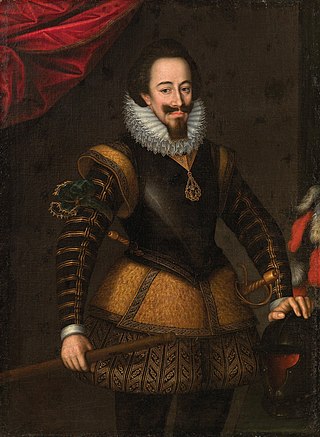
Charles Emmanuel I, known as the Great, was the Duke of Savoy and ruler of the Savoyard states from 30 August 1580 until his death almost 50 years later in 1630. He was nicknamed Testa d'feu for his rashness and military aggression.

James Shirley was an English dramatist.

Francis I of the Two Sicilies was King of the Two Sicilies from 1825 to 1830 and regent of the Kingdom of Sicily from 1806 to 1814.
The King's Men was the acting company to which William Shakespeare (1564–1616) belonged for most of his career. Formerly known as the Lord Chamberlain's Men during the reign of Queen Elizabeth I, they became the King's Men in 1603 when King James I ascended the throne and became the company's patron.

Elisabeth of France, or Elisabeth of Valois, was Queen of Spain as the third wife of Philip II of Spain. She was the eldest daughter of Henry II of France and Catherine de' Medici.

John, Prince of Asturias and Girona, was the only son of King Ferdinand II of Aragon and Queen Isabella I of Castile, and heir apparent to both their thrones for nearly his entire life.

Maria Isabella of Spain was Queen of the Two Sicilies from 4 January 1825 until 8 November 1830 as the wife of Francis I of the Two Sicilies.

Infanta María Luisa Fernanda of Spain, Duchess of Montpensier was the younger daughter of King Ferdinand VII of Spain and his fourth wife and niece, Maria Christina of the Two Sicilies. She became Duchess of Montpensier by marriage to her first cousin once removed, Antoine, Duke of Montpensier.
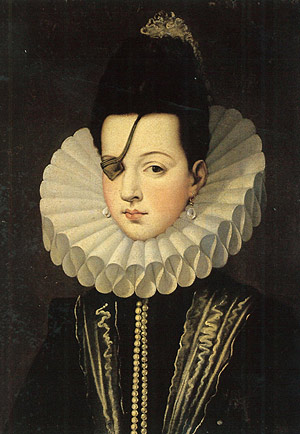
Ana de Mendoza de la Cerda y de Silva Cifuentes, Princess of Eboli, Duchess of Pastrana, was a Spanish aristocrat, suo jure 2nd Princess of Mélito, 2nd Duchess of Francavilla and 3rd Countess of Aliano.

The Malcontent is an early Jacobean stage play written by the dramatist and satirist John Marston ca. 1603. The play was one of Marston's most successful works. It is widely regarded as one of the most significant plays of the English Renaissance; an extensive body of scholarly research and critical commentary has accumulated around it.
The Coronation is a Caroline era stage play, a tragicomedy written by James Shirley, and notable for the tug-of-war of authorship claims in which it was involved in the middle seventeenth century.
The Young Admiral is a Caroline era tragicomedy written by James Shirley, and first published in 1637. It has often been considered Shirley's best tragicomedy, and one of his best plays.
The Sisters is a Caroline stage play, a comedy written by James Shirley. It was the last of Shirley's plays performed in London prior to the closing of the theatres in September 1642, at the start of the English Civil War. "Slight in substance, The Sisters is excellent in matter of technique, and especially in...structural unity...."

Infante Francisco de Paula of Spain was an Infante of Spain and the youngest son of Charles IV of Spain and Maria Luisa of Parma. He was a brother of Ferdinand VII, as well as the uncle and father-in-law of Isabella II.
The Politician is a Caroline era stage play, a tragedy written by James Shirley, and first published in 1655.
The Imposture is a Caroline era stage play, a tragicomedy written by James Shirley and first published in 1652. Shirley himself considered The Imposture the best of his romantic comedies.
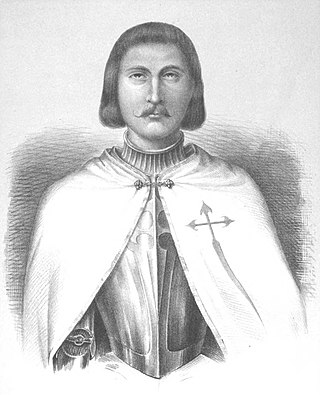
Beltrán de la Cueva y Alfonso de Mercado, 1st Duke of Alburquerque was a Spanish nobleman who is said to have fathered Joanna, the daughter of Henry IV of Castile's wife Joan of Portugal. His alleged daughter, called "la Beltraneja", was deprived of the crown of Castile because of the uncertainty regarding her parentage.
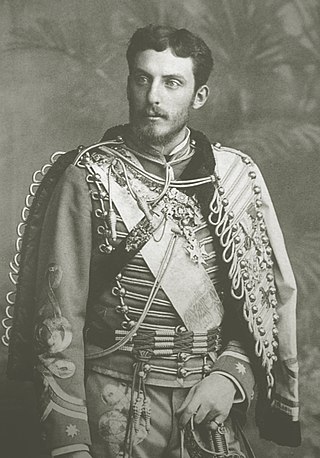
Infante Antonio, Duke of Galliera, was a member of the Spanish and French royal families. He was the son of Antoine d'Orléans, Duke of Montpensier, and Infanta Luisa Fernanda of Spain. Infante Antonio was a grandson of King Louis Philippe I of France on his father's side and King Ferdinand VII of Spain on his mother's side.
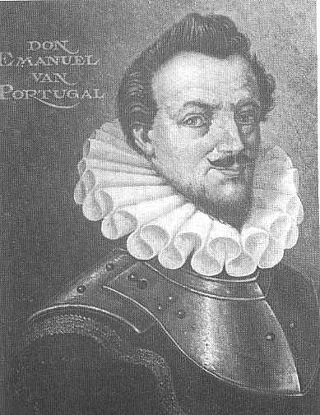
Manuel of Portugal was the illegitimate son of António, Prior of Crato, pretender to the Portuguese throne during the 1580 Portuguese succession crisis. He secretly married in 1597 Countess Emilia of Nassau, daughter of William the Silent and Anna of Saxony.












